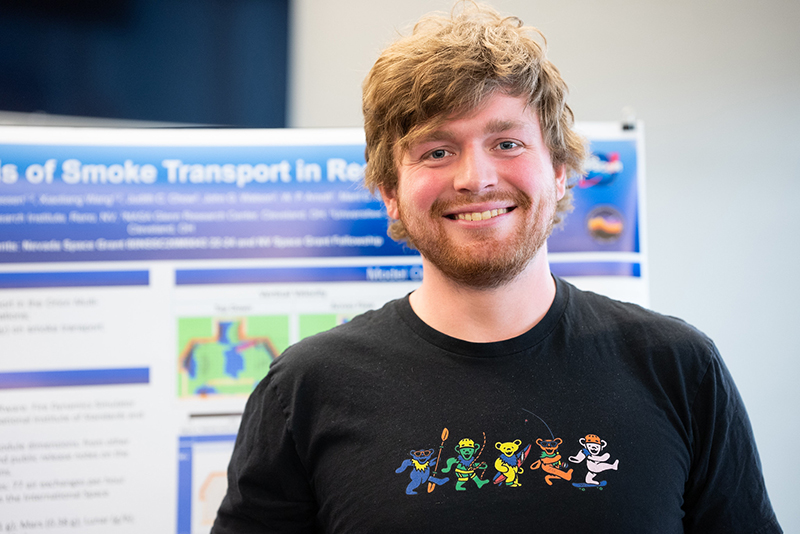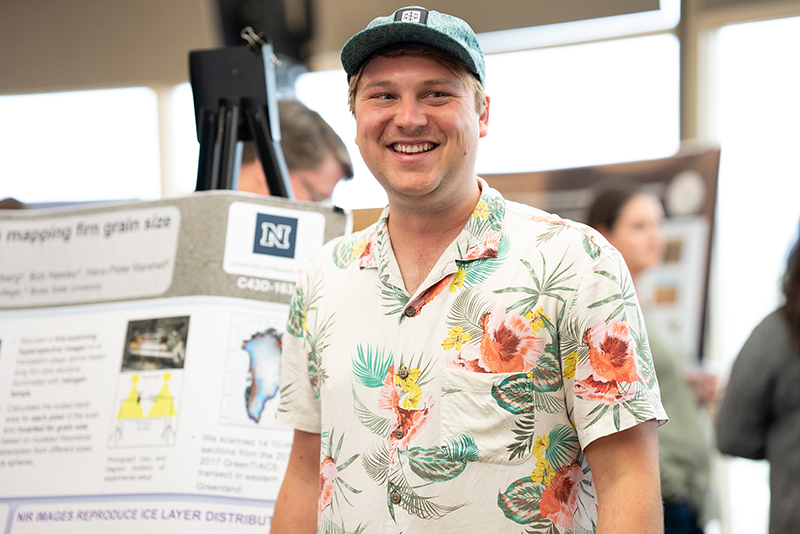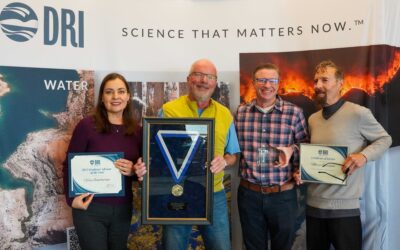On Friday, April 26th, 16 graduate students presented their research at DRI’s Reno campus for the annual poster presentation session. Organized by Kathleen Rodrigues, PhD, assistant research professor of luminescence, the poster session offers an opportunity for DRI-affiliated graduate students to network with each other and with DRI faculty, hone their presentation skills, and showcase the research they’re working on in pursuit of their degrees. Their scientific interests span a range of topics, from microplastics in the Truckee River, to the impacts of wildfire smoke pollutants on the climate. The three winning students selected for their exceptional science communication skills are highlighted below.
For more information about ways to conduct graduate research at DRI while earning a degree through UNR or UNLV, visit https://www-dev.dri.edu/education-workforce-development/graduate-programs/.

Salix Bair
Advisor: Dr. Xiaoliang Wang
Second-year Atmospheric Science M.S. student
Project Title: Design and Evaluation of a Wide Size Range Aerodynamic Focusing Lens
1. What problem is your research seeking to solve?
My project aims to design and test an inlet for an aerosol mass spectrometer that allows for real-time analysis of the entire size range of aerosols important to human health and atmospheric processes.
2. What is the most important thing you want people to know about your research?
Current aerodynamic focusing lenses only work on very narrow aerosol size ranges. This means we can’t study real-time concentrations and composition of the aerosols that affect human health and the environment. My project aims to solve this problem.
3. What do you want your DRI colleagues to know about you?
I love mountain biking! My favorite trail is Western States just outside of Tahoe City. My goal this year is to bike 2,000 miles.

Bjoern Bingham
Advisor: Dr. Xiaoliang Wang
M.S. student in Atmospheric Science
Project Title: Numerical Analysis of Smoke Transport in Reduced Gravity. This project is for the Nevada NASA Space Grant Fellowship as part of Bingham’s thesis work on the toxic gas and particle emissions from the combustion of spacecraft materials and smoke transport in reduced gravity.
1. What problem is your research seeking to solve?
We are trying to identify key gas species and particle size distributions emitted from common spacecraft materials to gain a better understanding of how we could more quickly detect fires on spacecrafts, which is critical to the safety of the astronauts and mission feasibility. We’re also identifying how smoke is transported in a spacecraft while in orbit or on another planet to better understand key ventilation design points and where to place smoke detectors.
2. What is the most important thing you want people to know about your research?
The key takeaway from modeling smoke transport is that ventilation design in reduced gravity plays the main role in determining where the smoke goes and how quickly the air can be cleaned from the toxins observed in our experimental research.
3. What do you want your DRI colleagues to know about you?
I’m a passionate outdoorsman and love working with my hands. I would like to find a job where I can balance my time spent at the desk with field and lab work.

Ian McDowell
Advisor: Dr. Kaitlin Keegan, UNR
Fourth year Ph.D. student in Hydrology through the Graduate Program of Hydrologic Sciences
Project Title: A cold laboratory hyperspectral imaging system mapping grain size and ice layer distributions in firn cores
Dissertation: Advancing observational and modeling capabilities of firn structure – meltwater feedbacks across the Greenland Ice Sheet.
1. What problem is your research seeking to solve?
The ‘big picture’ question that motivates my research is how fast will increased surface melting across the Greenland Ice Sheet raise future sea levels? To help answer this question, I study firn, which is the intermediate material between fresh snow that falls on the ice sheet surface and glacial ice. Firn contains connected air pockets that slowly close off into bubbles in glacial ice as the firn compresses under its own weight. Firn covers approximately 90% of the Greenland Ice Sheet, so as the extent of surface melt increases, more regions underlain by firn will experience summer melting. Meltwater generated on the surface will not immediately runoff into the ocean; instead, it will percolate downward into the firn and be stored as it refreezes. The goal of my PhD research is to improve both our observations of detailed firn microstructure (such as grain size), which controls the hydraulic properties regulating water flow, and model parameterizations that govern meltwater percolation in computer simulations. This work hopefully will help to improve our estimates of how long it will take to fill up the firn layer with meltwater, which will then allow it to runoff into the oceans and raise sea levels.
2. What is the most important thing you want people to know about your research?
While firn acts like a giant ‘sponge’ that can soak up meltwater, not all the firn’s pore space is available for meltwater storage. Meltwater that refreezes near the ice sheet surface can form ice layers, impermeable barriers that route meltwater off the surface more rapidly than if the entire firn layer filled with water. The structure of these ice layers appears to be different depending on the firn structure and temperature, and these differences in their characteristics may affect how the fuse together to become impermeable across large regions. Generally, we expect these near-surface ice layers to continue to spread inland and increase the area of the meltwater runoff zone. However, our climate actions can make a difference! Controlling future carbon emissions can be the difference between the runoff zone from ice layers increasing from 2x the current extent to 3x the current extent, which is a large extent!
3. What do you want your DRI colleagues to know about you?
My dog, Tava, is about as well-educated as I am! I have had her since I was a senior in college. She has gotten her BA, MS, and in a few months, she will earn her PhD with me!


